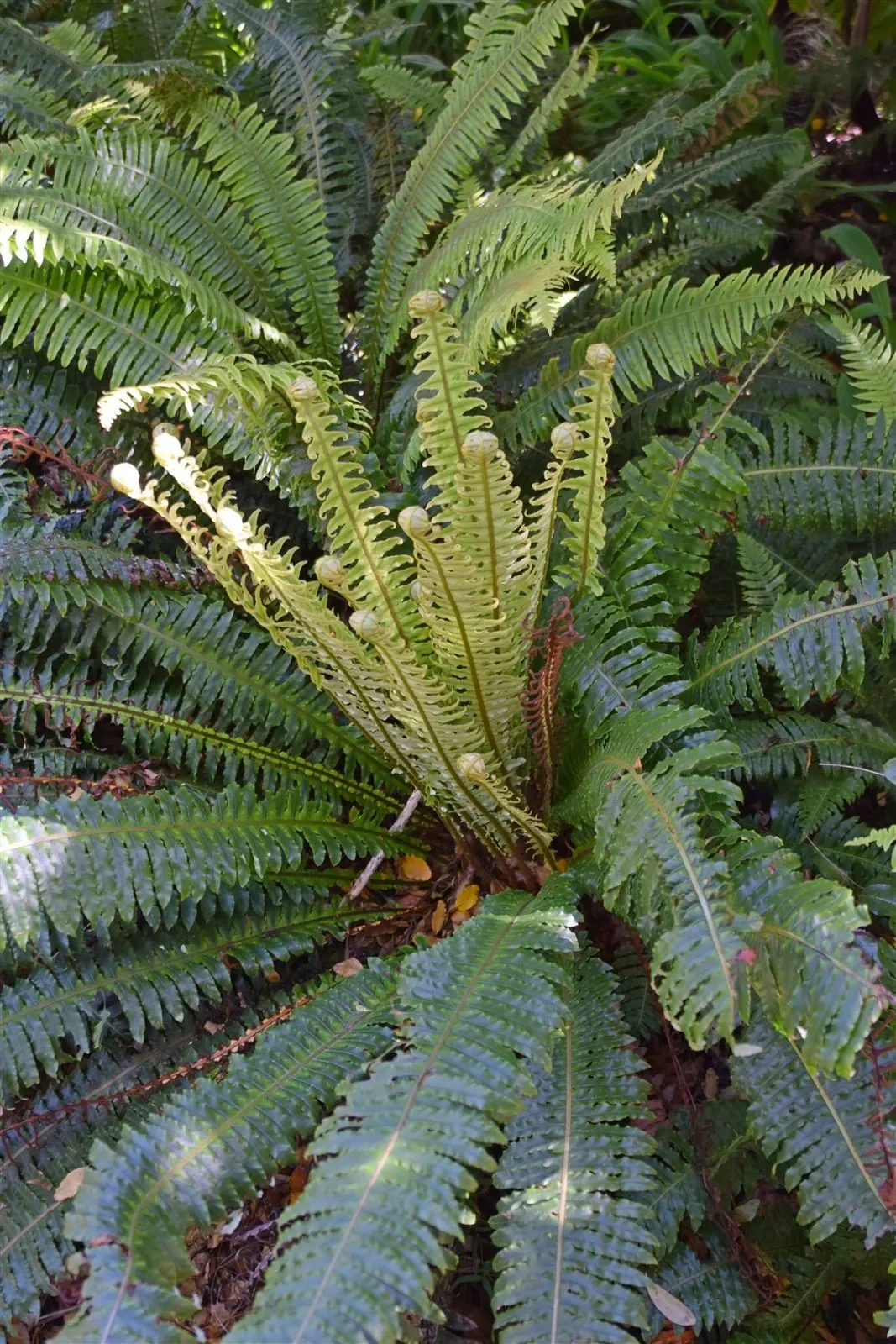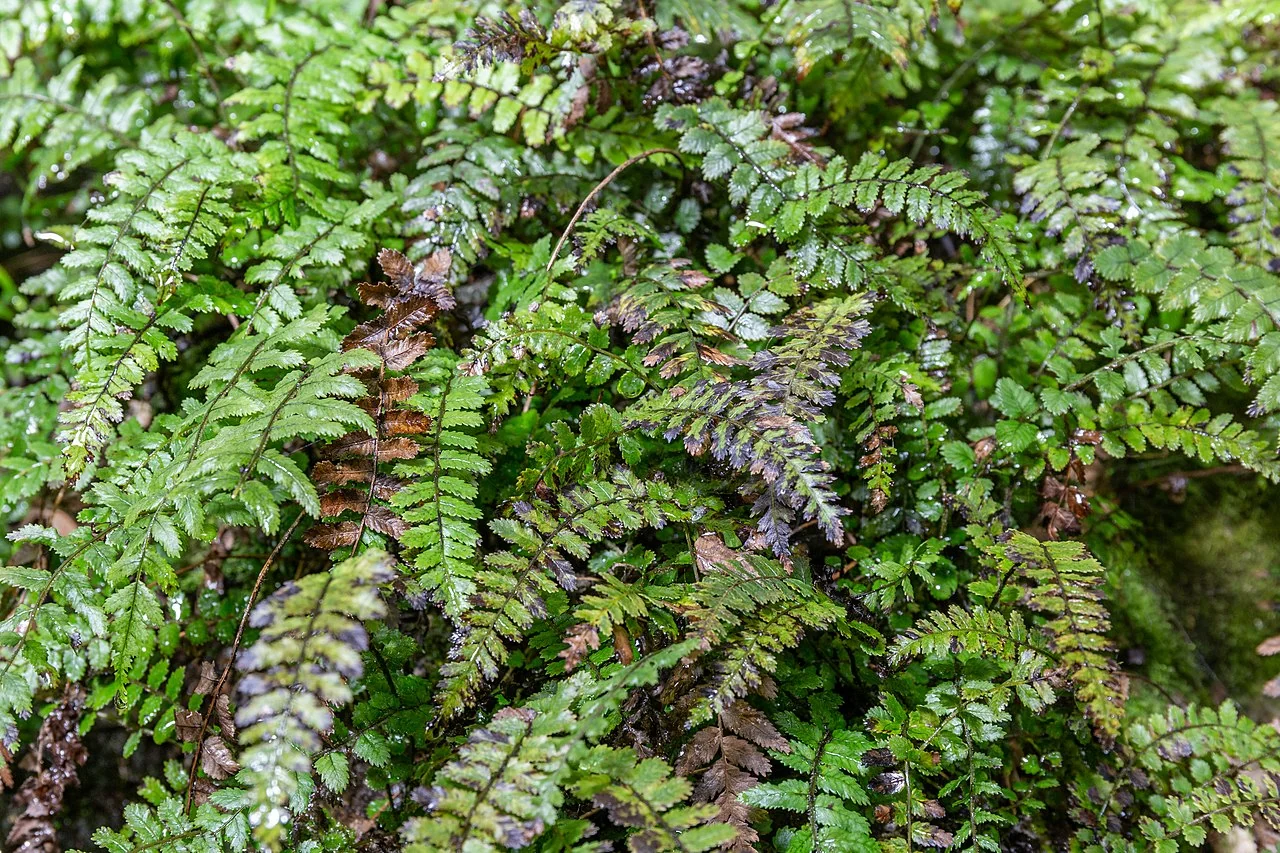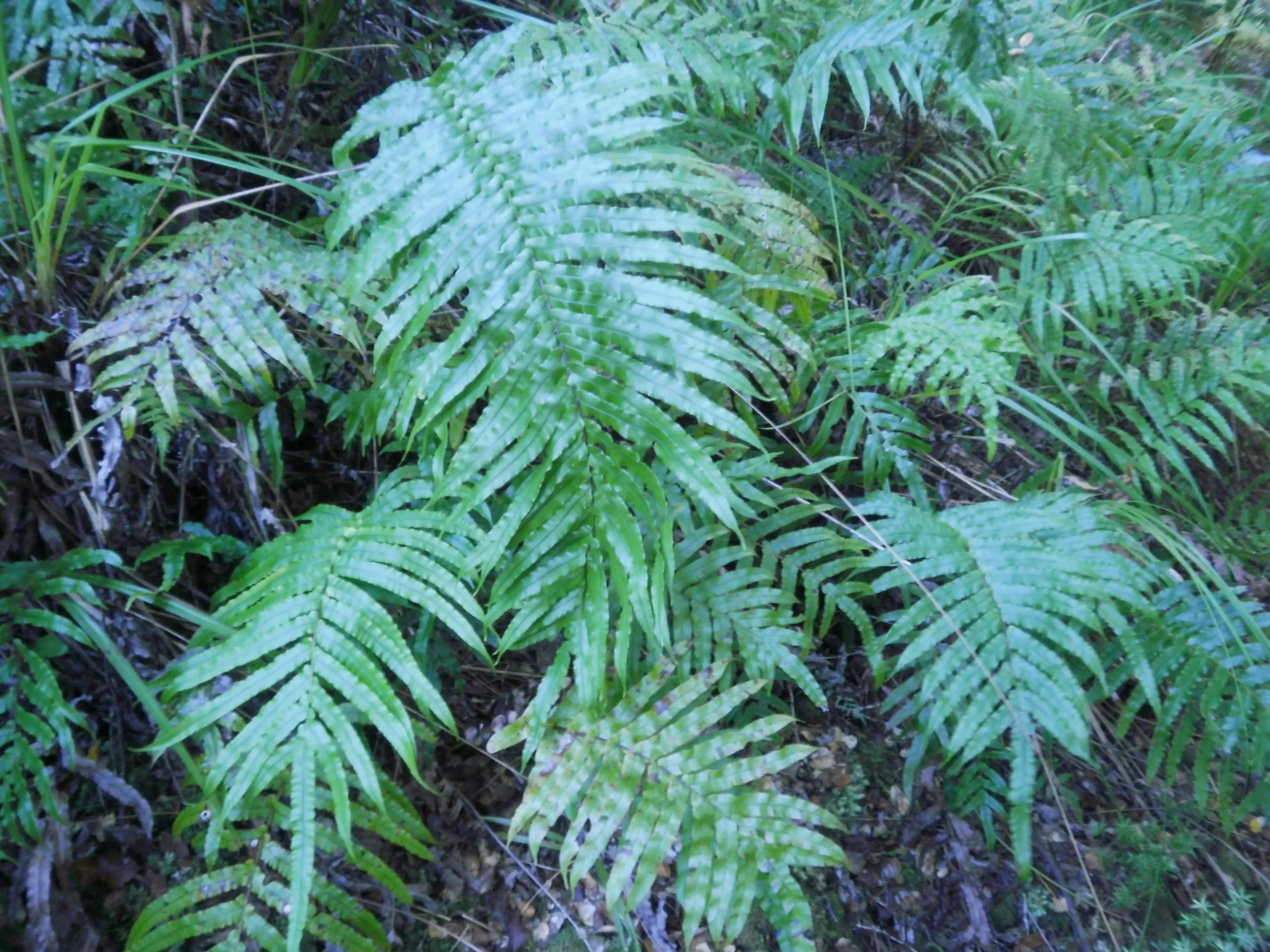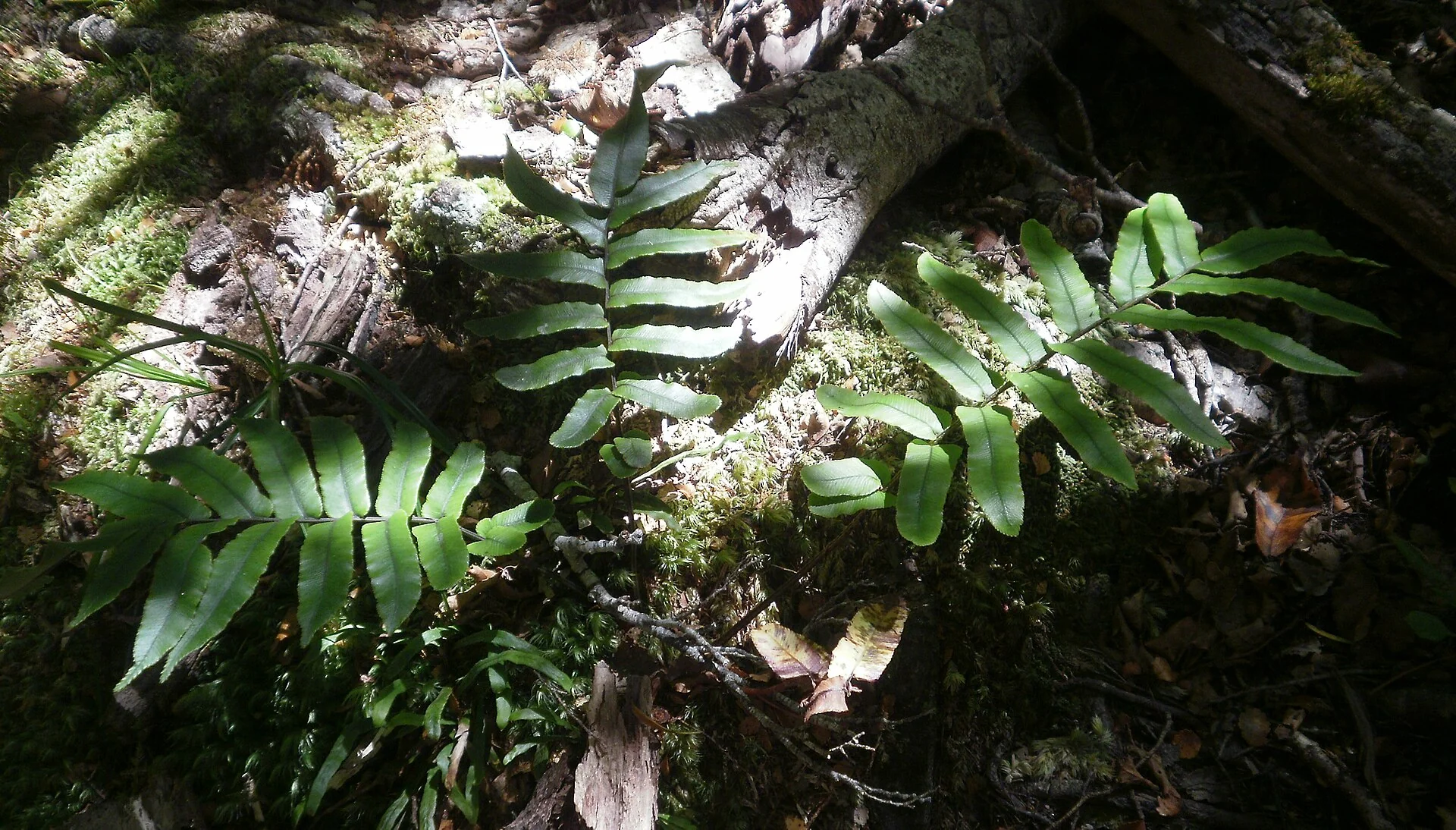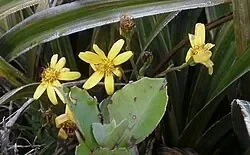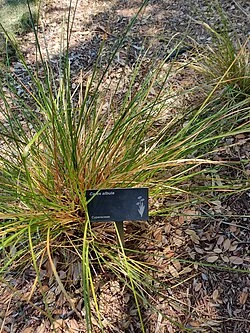
Lance Fern
Blechnum chambersii
Explore more NZ native plant guides in our index.
Introduction
About Lance Fern
Blechnum chambersii, commonly known as Lance Fern or Nini, is a small, elegant native fern of New Zealand. It is characterized by its glossy, dark green, lance-shaped fronds that grow in a compact rosette. This fern is often found in damp, shady areas of forests, along stream banks, and on rocky outcrops.

Plant Description
Blechnum chambersii, or Lance Fern, is a small, tufted fern with distinct sterile and fertile fronds. The sterile fronds are lance-shaped, deep green, and arch gracefully, while the shorter, upright fertile fronds are much narrower. This fern typically grows in damp, shaded areas, often on stream banks or moist rock faces. Its compact size and elegant appearance make it a popular choice for shaded gardens and ferneries.
Quick Facts
Fern Summary
| Scientific Name | Blechnum chambersii |
|---|---|
| Height | 10-30 cm |
| Spread | 10-20 cm |
| Water Needs | Moderate to high; prefers consistently moist soil |
| Light | Partial to full shade |
| Frost Tolerance | Moderate |
| Salt Tolerance | Low |
| Growth Rate | Slow |
| Lifespan | Perennial |
Climate Best Suited to
Blechnum chambersii is found throughout New Zealand in lowland to montane forests. It thrives in a mild, humid climate with consistent moisture and protection from strong winds and direct sunlight.
Regional Suitability
| City | Climate Suitability |
|---|---|
| Whangārei | Ideal |
| Auckland | Ideal |
| Hamilton | Ideal |
| Tauranga | Ideal |
| Rotorua | Ideal |
| Gisborne | Ideal |
| New Plymouth | Ideal |
| Napier | Ideal |
| Whanganui | Ideal |
| Palmerston North | Ideal |
| Wellington | Ideal |
| Nelson | Ideal |
| Christchurch | Ideal |
| Dunedin | Ideal |
| Invercargill | Ideal |
Habitat
Blechnum chambersii, commonly known as Lance Fern, is a widespread native fern found across New Zealand, as well as in parts of Australia (including South Australia, New South Wales, Victoria, and Tasmania), Norfolk Island, and Fiji. This fern typically thrives in consistently moist, cool, and humid microclimates, preferring shaded to deeply shaded conditions and actively avoiding direct sunlight.
Its natural habitats span from coastal to montane forests, where it can be found in various specific locations:
- Stream Banks and Damp Rock Walls: It frequently colonizes shaded stream banks and damp rock walls, benefiting from the consistent moisture and protection from direct sun.
- Limestone Areas and Overhangs: Lance Fern is often found in limestone areas, near cave entrances, and under overhangs, where the conditions are cool and shaded.
- Near Waterfalls: It thrives in the spray zone of waterfalls, where high humidity and constant moisture are prevalent.
- Forest Floor and Wet Gullies: It is a common sight on the forest floor, particularly in wet gullies, and can also be found in rock crevices and rocky banks.
- Epiphytic Growth: Occasionally, it grows as a low epiphyte, attaching itself to tree trunks or branches in very humid environments.
Lance Fern grows well in organic-rich, humus-based, consistently moist, and well-draining soils, including those found in limestone areas. It can be found under various tree types such as kauri, podocarp, broadleaved, beech, mnuka, knuka, and coastal scrub, and even under Salix species in swampy areas.
Plant Conservation
Threats and Efforts
Lance Fern (Blechnum chambersii, now Austroblechnum lanceolatum) is a native New Zealand fern with a national conservation status of "Not Threatened." This classification reflects its widespread distribution and ability to thrive in suitable damp, shaded habitats throughout New Zealand forests.
Despite its secure national status, lance fern faces ongoing conservation challenges that require continued habitat protection and management. The primary threats include habitat loss and degradation through deforestation, land conversion, and the modification of stream margins and forest understories where this species naturally occurs. Its preference for consistently moist, shaded conditions makes it vulnerable to changes in forest canopy cover and alterations to natural water flow patterns. Competition from invasive plant species and disturbance from recreational activities in native forests can also impact local populations. Conservation efforts focus on protecting intact forest ecosystems, maintaining natural stream and wetland margins, controlling invasive species, and promoting appropriate forest management practices that preserve understory diversity. Its role as an indicator species for healthy forest ecosystems makes its conservation valuable for monitoring broader forest health and biodiversity. By supporting native forest protection, sustainable land management practices, and public education about the importance of forest understory species, we can help ensure the continued survival of this ecologically important native fern.
Growing Requirements
Soil Requirements
Prefers moist, well-drained, humus-rich soil.
Light Requirements
Thrives in partial to full shade. Avoid direct sunlight, which can scorch the fronds.
Water Requirements
Requires consistent moisture, especially during dry periods. Do not allow the soil to dry out completely.
Planting Guide
-
When to Plant
Plant in autumn or spring.
-
Site Preparation
Choose a shady site with moist, well-drained, humus-rich soil.
-
Planting and Aftercare
Dig a hole twice the width of the root ball. Place the fern in the hole, ensuring the crown is level with the soil surface. Backfill with soil and water thoroughly. Apply a layer of mulch.
Ecological Significance
Blechnum chambersii, also known as Lance Fern, Nini, or Rereti, holds significant ecological importance within its native habitats, primarily due to its role in stabilizing understory environments and supporting biodiversity in moist, shaded areas.
- Understory Stabilization and Moisture Retention: This fern functions as a reliable understory stabilizer, particularly in shaded gullies and riparian forests. Its dense rosettes effectively protect soil on banks, intercepting splash and runoff, and contributing significantly to moisture retention within the ecosystem. This helps create and maintain the humid microclimates essential for many other forest species.
- Indicator Species: The presence and abundance of Blechnum chambersii often serve as an indicator of healthy forest understory conditions, suggesting a stable and well-functioning ecosystem with adequate moisture and shade.
- Habitat Provision: The fern's growth habit creates sheltered niches that support various invertebrates and bryophytes (mosses and liverworts), thereby contributing to local biodiversity. These microhabitats are crucial for the survival of smaller organisms within the forest floor.
- Habitat Specialization: Blechnum chambersii thrives in consistently moist, cool, and humid microclimates with organic-rich, free-draining soils. It is particularly abundant in limestone areas and cave entrances, as well as on shaded stream banks, damp rock walls, and under dense forest canopies. This specialization highlights its role in specific ecological niches.
- Reproduction and Dispersal: Its efficient spore production facilitates dispersal to new, suitable humid microsites, aiding in its propagation and the colonization of new areas, thus ensuring its continued presence and ecological function.
Being widespread across New Zealand and other Pacific regions, Blechnum chambersii is a resilient component of these ecosystems, though its reliance on consistent moisture and shade makes it sensitive to habitat disturbance and changes in environmental conditions.
Uses & Significance
Garden Uses
- An excellent fern for shady borders, woodland gardens, rockeries, and containers.
- Its compact size makes it suitable for smaller spaces.
Landscaping Uses
Blechnum chambersii, also known as Lance Fern, Nini, or Rereti, is a versatile native fern with several valuable landscaping applications, particularly in shaded and moist garden environments. Its elegant form and preference for specific microclimates make it an excellent choice for creating naturalistic and serene garden spaces.
- Ferneries and Woodland Gardens: It is ideally suited for ferneries and woodland gardens, where its presence helps create an authentic forest character and texture. Its preference for shaded, moist conditions allows it to thrive in these settings.
- Shaded Stream Edges and Riparian Plantings: This fern naturally thrives along shaded stream edges, riverbanks, and within the spray zones of waterfalls. In landscaping, it can be used to stabilize soil on banks and create sheltered niches in riparian plantings.
- Understorey Planting: Blechnum chambersii can be effectively used as an understorey plant, pairing well with other shade-tolerant native species like nikau palms and kawakawa to create lush, layered ground cover.
- Damp Rock Walls and Limestone Areas: It luxuriates in limestone country, near cave entrances, and on damp rock walls, making it a perfect candidate for rock gardens or features that mimic these natural environments.
- Creating a "New Zealand Forest Floor" Aesthetic: Its distinctive dimorphic fronds and compact growth habit make it excellent for achieving a naturalistic New Zealand forest floor atmosphere in shaded gardens, contributing to a sense of tranquility and authenticity.
- General Garden Uses: Beyond specialized settings, it can be incorporated into borders, living areas, paths, steps, and pool areas, fitting various garden styles including backyard, city & courtyard, frontyard, Japanese, modern, and native designs. It is also suitable for creating enchanted walkways.
For successful growth in landscaping, Blechnum chambersii requires shade to deep shade, protection from direct sun, consistently moist and well-draining soil rich in humus, and shelter from drying winds. It is a slow-growing perennial, typically reaching a height of 0.12-0.65 meters and a spread of 0.2-0.4 meters.
Seasonal Care Calendar
Spring
- Apply a layer of compost or leaf mould to enrich the soil and retain moisture.
Summer
- Water regularly, especially during dry periods.
Autumn
- No special care required.
Winter
- Protect from heavy frosts in colder regions.
Pruning and Maintenance
Frond Management
Remove any old, damaged, or yellowing fronds as needed to maintain the plant's neat appearance and encourage healthy new growth.
Prune Lance Fern lightly to maintain structure; remove damaged shoots and avoid hard cuts on older wood.
How to Grow Lance Fern
From Spores
Propagating Lance Fern from spores is the natural method but requires patience and specific conditions. This method allows you to grow new plants from the fern's reproductive spores. Spore propagation connects you to the fern's ancient reproductive cycle and provides an understanding of fern biology. The process requires sterile conditions and careful attention to humidity and temperature. Success rates can vary but typically improve with experience and proper technique. This method is ideal for large-scale propagation or for gardeners who enjoy challenging horticultural projects.
- Collect fertile fronds when the sori (spore clusters) are mature and brown, usually in late summer to autumn
- Place fertile fronds in a paper bag and allow spores to release naturally over 1-2 days
- Sow spores immediately on sterile, moist growing medium of equal parts peat and fine sand
- Cover container with glass or plastic to maintain high humidity (80%) and place in indirect light
- Maintain consistent moisture and temperature between 20-24°C for optimal germination
- After 2-3 months, tiny green prothalli will appear, followed by small ferns in 6-12 months
- Transplant individual ferns when they reach 2-3 cm tall into small pots with humus-rich soil
Spore propagation typically takes 12-18 months to produce plantable specimens.
From Division
Division is the most reliable and straightforward method for propagating Lance Fern, suitable for home gardeners wanting quicker results. This method takes advantage of the fern's natural clumping growth habit and established root system. Division produces mature plants much faster than spore propagation and maintains the exact characteristics of the parent plant. The process works well because Lance Fern naturally forms multiple crowns that can be separated successfully. This method also helps rejuvenate older clumps that may have declined in vigor.
- Choose a mature, healthy plant with multiple crowns in early spring before new growth begins
- Carefully dig around the plant to expose the rhizome system without damaging roots
- Using a clean, sharp knife, divide the rhizome ensuring each section has at least one growth bud and healthy roots
- Allow cut surfaces to dry for a few hours to prevent rot
- Plant each division in prepared soil with good drainage and high organic content
- Water gently to settle soil and maintain consistent moisture during establishment
- Keep in shaded location and protect from wind until new growth appears
Divided plants typically establish within 6-8 weeks and will develop into full-sized specimens within 1-2 growing seasons.
From Rhizome Cuttings
This method works well for Lance Fern as it naturally spreads through underground rhizomes that can be sectioned to create new plants. Rhizome cuttings offer an alternative propagation approach that falls between spore sowing and division in terms of difficulty and time to establishment. This technique is particularly useful when you want to create multiple plants from a single parent without disturbing the main clump. The success rate is generally high when proper conditions are maintained, and it allows for precise control over the number of new plants produced.
- In early spring, carefully excavate healthy rhizomes from an established plant
- Cut rhizomes into 5-7 cm sections, ensuring each piece has at least one visible bud
- Plant sections horizontally in pots filled with well-draining, humus-rich potting mix
- Cover lightly with 1-2 cm of soil and water gently to settle
- Place in a shaded, protected area and maintain consistent moisture
- New shoots should emerge within 4-6 weeks if conditions are suitable
- Allow to establish for 2-3 months before transplanting to permanent locations
Pests & Diseases
Generally Hardy
Generally pest and disease free. May be susceptible to root rot in poorly drained soils.
Cultural Significance
While not as widely documented for traditional Mori uses as some other ferns, the Lance Fern (Blechnum chambersii) was recognized for its presence in healthy forest ecosystems. Its fronds may have been used for weaving or other purposes, and the plant was likely used in rongo (traditional Mori medicine) for various ailments.
Bonus Tip
Blechnum chambersii is excellent for creating an authentic New Zealand forest floor atmosphere in shaded gardens. Its dimorphic fronds, with distinctly different sterile and fertile forms, are botanically fascinating. For best results, plant it near water features or in consistently moist areas to observe the beautiful color progression from pinkish new growth to dark green-maroon mature fronds. This slow-growing fern is particularly stunning when planted in groups to mimic its natural colony-forming habit, with deep shade and consistent moisture being key to its success.
